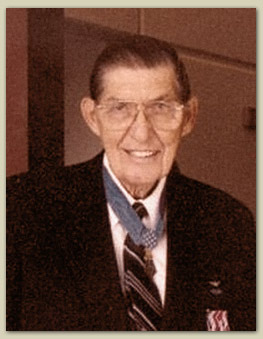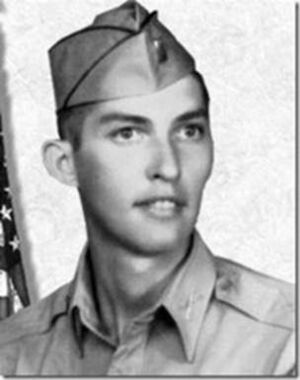Van T. Barfoot facts for kids
Quick facts for kids
Van Thomas Barfoot
|
|
|---|---|

Van T. Barfoot, Medal of Honor recipient
|
|
| Birth name | Van Thurman Barfoot |
| Born | June 15, 1919 Edinburg, Leake County, Mississippi (32°47′56″N 89°20′10″W / 32.799°N 89.336°W) |
| Died | March 2, 2012 (aged 92) Richmond, Virginia |
| Place of burial |
H. C. Smither Memorial Cemetery, Hudgins, Virginia
|
| Allegiance | |
| Service/ |
|
| Years of service | 1940–1974 |
| Rank | |
| Unit | |
| Battles/wars | World War II
Korean War Vietnam War |
| Awards | Medal of Honor Silver Star Bronze Star 3 Purple Hearts |
Van Thomas Barfoot (born Van Thurman Barfoot; June 15, 1919 – March 2, 2012) was a brave officer in the United States Army. He received the Medal of Honor, which is the highest award for bravery in the U.S. military. He earned this special award for his amazing actions during World War II.
Contents
Early Life and Heritage
Van Thomas Barfoot was born on June 15, 1919, in Edinburg, Mississippi. His grandmother was from the Choctaw people, a Native American tribe. Even though he could have joined the Choctaw Nation, his parents never officially enrolled him.
Military Career and Heroic Actions
Van Barfoot joined the Army in 1940 from Carthage, Mississippi. After his training, he served with the 1st Infantry Division in places like Louisiana and Puerto Rico. In December 1941, he became a sergeant.
World War II Battles
During World War II, Barfoot was sent to Europe. He took part in the Italian Campaign, which involved several landings from the sea. These included the Allied invasion of Sicily in July 1943, the invasion of mainland Italy at Salerno in September 1943, and the landings at Anzio in January 1944.
His unit moved inland from Anzio. By May 1944, they reached a small town called Carano in southern Italy. They set up defenses, and Barfoot went on patrols to scout the German lines.
Medal of Honor Actions
On May 23, 1944, Barfoot's company was ordered to attack. He was a technical sergeant and asked to lead a small group of soldiers. Because of his patrols, he knew the area well, including a minefield in front of the German position.
He bravely went forward alone through the minefield. He used ditches and low spots to get close to a German machine gun nest. He destroyed the gun and its crew with a hand grenade. Then, he entered the German trench. He moved towards a second machine gun, killing two enemy soldiers and capturing three others. When he reached a third machine gun, the entire crew gave up to him. In total, Barfoot captured 17 German soldiers and killed 8.
Later that day, the Germans launched a counterattack with three large Tiger tanks. Barfoot used a bazooka to disable the first tank. He then used his Thompson submachine gun to kill some of its crew, stopping the German attack. He then went into enemy territory and destroyed an abandoned German artillery piece. After that, he returned to his own lines and helped two wounded soldiers from his group get to safety.
After these heroic actions, Barfoot was promoted to second lieutenant. His division then moved into France. In September 1944, he learned he would receive the Medal of Honor. He chose to have the award ceremony right there in the field so his soldiers could be there. Lieutenant General Alexander Patch presented him with the medal on September 28, 1944, in Épinal, France.
After World War II
In 1945, a senator from Mississippi, Theodore G. Bilbo, asked Barfoot if he had trouble with African-American soldiers during the war. Barfoot, who grew up in a time when people were separated by race, gave a surprising answer. He said, "I found out after I did some fighting in this war that the colored boys fight just as good as the white boys...I've changed my idea a lot about colored people since I got into this war and so have a lot of other boys from the south." This showed how his experiences in the war changed his views.
Barfoot continued to serve in the Army. He fought in the Korean War and the Vietnam War. He was also awarded three Purple Hearts, which are given to soldiers wounded in battle. He rose through the ranks to become a colonel before he retired from the Army.
After retiring, he lived on a farm in Amelia County, Virginia, and later moved closer to his daughter in Henrico County, Virginia.
Flagpole Dispute
In December 2009, when Van Barfoot was 90 years old, he faced a problem with his neighborhood's homeowners' association (HOA). He had put up a 21-foot (6.4 m) flagpole and started flying the U.S. flag regularly on Veterans Day. The HOA told him to take it down because he hadn't gotten their approval. They said it was for "aesthetic reasons" (how it looked).
This story became public and quickly gained a lot of attention. Many people supported Barfoot, including 48,000 people on a Facebook page, the American Legion, military groups, and politicians like Virginia Senators Mark Warner and Jim Webb. Because of all the public support and outrage, the HOA dropped their request on December 8, 2009, ending the dispute in just one week.
Death
Van Barfoot passed away on March 2, 2012, at the age of 92. He had a fall in front of his home, which caused a skull fracture and bleeding in his brain. He died two days later.
Honors and Legacy
On October 9, 2009, a part of Mississippi Highway 16 was named the Van T. Barfoot Medal of Honor Highway. This section runs through his hometown of Edinburg. A building at the Richmond Veterans Administration Medical Center in Richmond, Virginia, is also named after him. In May 2022, it was recommended that Fort Pickett in Blackstone, Virginia, be renamed Fort Barfoot. This is part of a larger plan to rename military bases that were originally named after leaders of the Confederate Army.
See also


